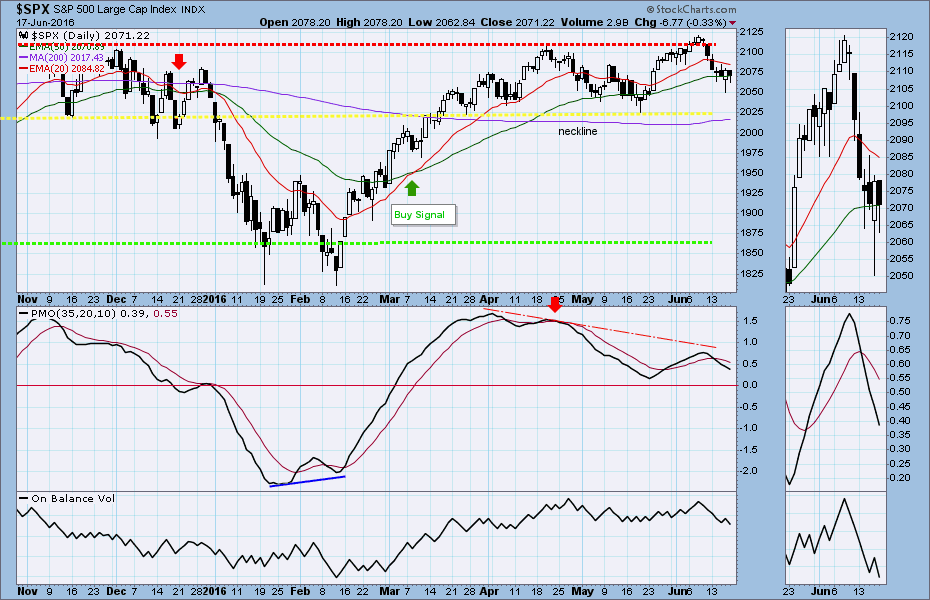The S&P 500 cash index ($SPX) closed at 2071.22 last Friday, down 24.85 points on the week for a 1.18% loss.
For the long-term, the significant point is the retreat from the long-term resistance around 2120-2130. That resistance dates back to February 2015 in a broad topping pattern formed after a very long bull market. The resistance has successfully rebuffed eight attempts to move past it in the past 17 months.
But the SPX has stubbornly returned to the high area each time, despite a couple of waterfall price declines that looked like the start of a new Bear market.
The current decline doesn’t look like a waterfall. It has managed to hold above important resistance levels – so far – and still shows fairly strong bounces.
We have to treat this market with suspicion; certainly it shows more risk than reward at this point, but we haven’t seen the rush for the exit a new Bear would require. So far.
Last week
Last week “quadruple witching” when options and futures contracts expire more-or-less simultaneously, and a Fed Open Market Committee report scrambled the market, to no apparent effect.
The index dropped sharply after the FOMC announcement Wednesday – somewhat surprisingly, given that the Fed all-but-explicitly promised no rate increases this summer and probably none this year. That dovish message has boosted stocks in the past.
But this time the SPX dropped to the resistance level around 2050, then bounced to just below 2080 (thank you, PPT) before falling back into the close. Option expiration contributed to the relatively modest volatility and relatively small range (about 50 points for the week).
This week
Watch for events outside the market to move prices this week. Fed Chair Janet Yellen testifies to Congress Tuesday, and in Britain the referendum to leave/stay in the European Union takes place on Thursday, probably with preliminary results available in the US early sessions Thursday morning.
Regardless of which side wins, the Brexit referendum will dominate the last half of the week, barring a declaration of war somewhere.
We expect Fed Chair Yellen to be dovish – i.e. anti-rate increase – in her congressional testimony, and reassuring about the positive signs in the US Economy.
On the Leave-the-EU referendum, the polls are too close to call (the Leave side looks to be slightly ahead). But all the big money wants to Remain, and one way or another the Big Money usually gets want it wants.
If they squeeze out a Remain victory that outcome should push US stocks higher, but there will be bitterness in Britain regardless of the result.
The debate has inflamed passions to the point an exit supporter murdered a pro-EU Member of Parliament last week. There will be accusations of dirty tricks from the loser, no matter who wins, and the repercussions will be felt in US (and European) markets.
If there is a Brexit rally, don’t fall in love with it. This is a situation where “irrational exuberance” may take the market further – in either direction – than it really wants to go.
Today
We trade the S&P 500 min-futures (ES) for our short-term positions, and they look relatively calm. The ES closed between the 20- and 40-day ema lines. Today more downside should be expected in early sessions.
2075 will be a key level to watch carefully. A failure to break out topside could lead the price back down to last week’s low area; eventually the 2020 level could be seen.
Based on the daily chart, the PMO indicator declines and the slow STO is in oversold area. That suggests the ES could have a brief bounce, but may not be able to hold the gain.
Major support levels: 2043.50-46.50, 2035.50-34.75, 2023-20, 2011.50-09
Major resistance levels: 2089.50-93.50, 2107.50-05.50, 2119.50-21.50
Visit Naturus.com to see detailed previews for gold and the ES for the week ahead. Free.
Chart: SPX Daily chart to June 17, 2016





